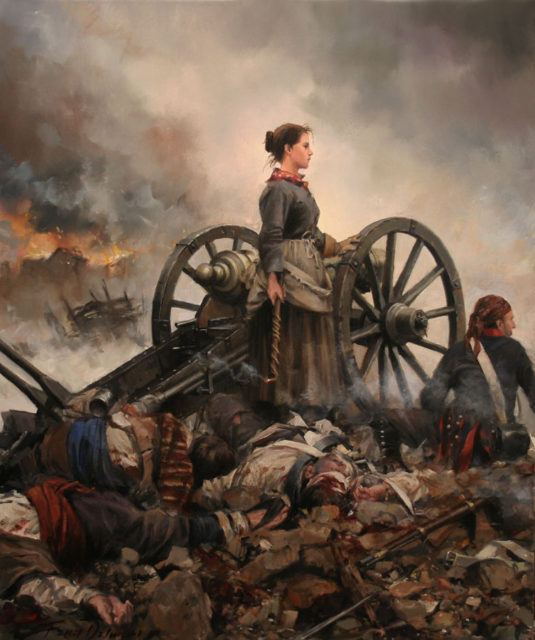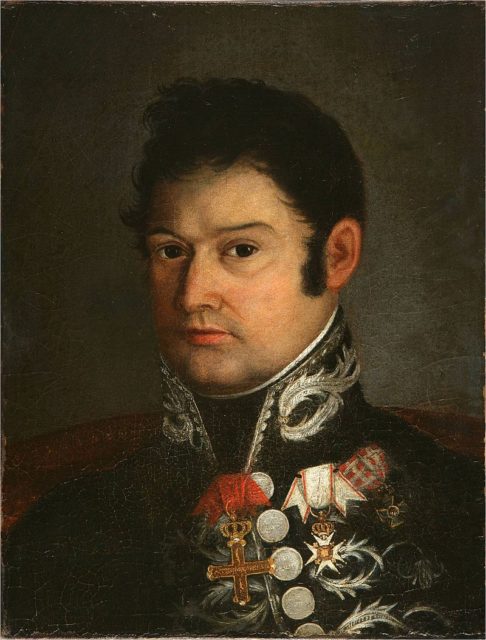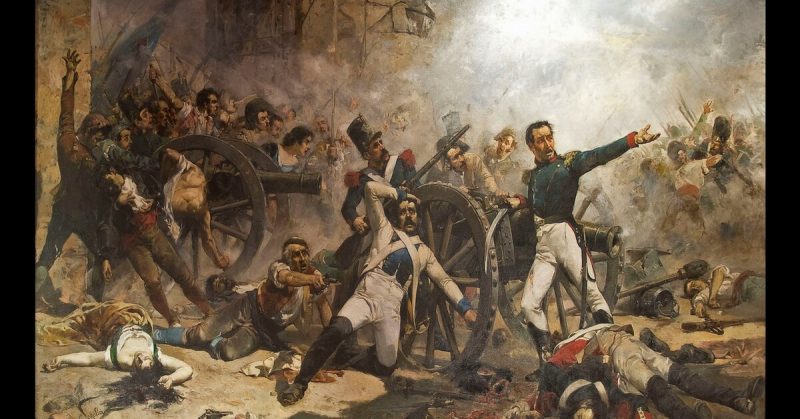In 1807, the forces of Napoleonic France entered Spain on their way to invade Portugal. The following year, they took control of Spain itself. For the next six years, Spaniards fought to drive out the French. Some were guerrillas, others regular army officers. All became heroes of a country seeking its freedom.
Agostina Zaragoza
Agostina was the most popular heroine of the war and an icon of resistance. Known as the Maid of Saragossa, she took her surname from the city that was her home and for which she fought to defend.
During the Siege of Saragossa, Agostina’s lover was killed while manning a cannon. She took his place, keeping the gun in action and motivating those around her. She was made a sub-lieutenant of artillery and traveled to Cadiz, where she appeared in public in her uniform as a source of inspiration.
Agostina became famous across Spain and beyond. Francisco Goya portrayed her in his print Que Valor! Another artist, Sir David Wilkie, painted her manning the gun and Byron immortalized her in his poetry. Her image was captured in words as well as pictures.

General Benito San Juan
San Juan was a commander of regular troops who faced a difficult time early in the war. In 1808, he was put in command of Spanish forces defending Madrid against the advancing French. Ordered to defend Somosierra pass, he divided his forces and was defeated by Napoleon. As he tried to pull his reserves together to fight on, he was hit in the head twice by sword-cuts.
Despite his wounds, San Juan pressed on. However, his troops did not trust his intentions. They mutinied at Talavera six days later, accusing him of wanting them to surrender to the French. He tried to escape but was shot and hanged from a tree.
General Juan Diaz Porlier
Porlier began his military career in the Spanish Navy. There, he fought alongside Spain’s French allies at the Battle of Trafalgar in 1805.
When the French invaded Spain, Porlier became a guerrilla commander. Many of his recruits had been soldiers before their units were dispersed. That, together with his military experience, allowed him to raise a force that was closer to regular troops than most guerrilla bands.
Persistent, courageous, and audacious, Porlier was known as El Marquesito; the little Marquis. Working under the authority of the Junta, the government of resistance, he harried the French in the northern provinces.
Many of Porlier’s successes were achieved in collaboration with the British Royal Navy, especially Captain Home Riggs Popham. Together, they launched raids against the French along the coast, Porlier seizing French positions and then withdrawing when enemy reinforcements arrived.
In August 1812, while Porlier was besieging Santoña, troops led by his deputy played a prominent part in the capture of the strategically vital town of Santander.
Xavier Mina y Larrea
Only 19 years old when the French invaded, Xavier Mina was one of the youngest guerrilla leaders. He was given the nicknames El Mozo (the youth) and El Estudiante (the student).
Mina was an incredibly skilled commander who took to the different tactics needed for irregular warfare. His forces undertook major operations, dispersed when large French troops pressed in and then reassembled to start again.
On March 31, 1810, he was cornered by two French forces and captured. He remained a prisoner of war until 1814.
General Francisco Espoz y Mina
Francisco Espoz Ilundain was a humble yeoman from Navarre. When the French invaded, he joined the guerrilla group of his nephew, Xavier Mina. When Mina was captured in 1810, Francisco changed his surname to Espoz y Mina in honor of Xavier and took command of the group.
A gift for guerrilla warfare clearly ran in the family. Espoz y Mina became one of the best guerrilla leaders of the war. He led a force of up to 3,000 in action across Navarre, Aragon, and beyond. He worked with other guerrilla leaders, including Porlier, and with the British Navy in the raids led by Popham.

Espoz y Mina continued his nephew’s style of fighting. When defeated, his forces would disperse, gather elsewhere, and return to the fight. He was such a thorn in the side of the French that at one point he could claim that six of their generals were chasing him.
By the end of the war, he had forged his troops into a regular force funded by import levies. He earned the trust of the Duke of Wellington and took part in raids into France as the war moved out of the Peninsula and into Napoleon’s homeland.
General Francisco Longa
Longa started out leading irregular forces in Cantabria. Over time, they developed the discipline and fighting style of a regular unit. He was made a colonel in the regular army, taking his men into the military with him.
Longa and his men served with distinction at Vittoria and Tolosa. They captured the French garrison of Passages. While they had a good reputation as fighters, their reputation for discipline was not good. Wellington refused to take them with him to France for fear of the chaos they would cause.
General Baron Eroles
A civilian turned guerrilla commander, Eroles learned the craft of war through experience while fighting against the French. Despite his informal education, he became a skilled leader. Brave, competent, active, and determined, he helped to make life miserable for the French.
Don Julian Sanchez
From a relatively small start, Sanchez raised one of the most efficient and orderly guerrilla forces in the Peninsula. His troops included lancers dressed in uniforms they captured from the French. A potential for confusion, but one that lent them an air of professionalism that many guerrillas lacked.
Fighting primarily in Old Castile, they were especially helpful to Wellington as he pushed the French back and assisted the Spanish in regaining their freedom.
Source:
Philip Haythornthwaite (2004), The Peninsular War: The Complete Companion to the Iberian Campaigns 1807-14
